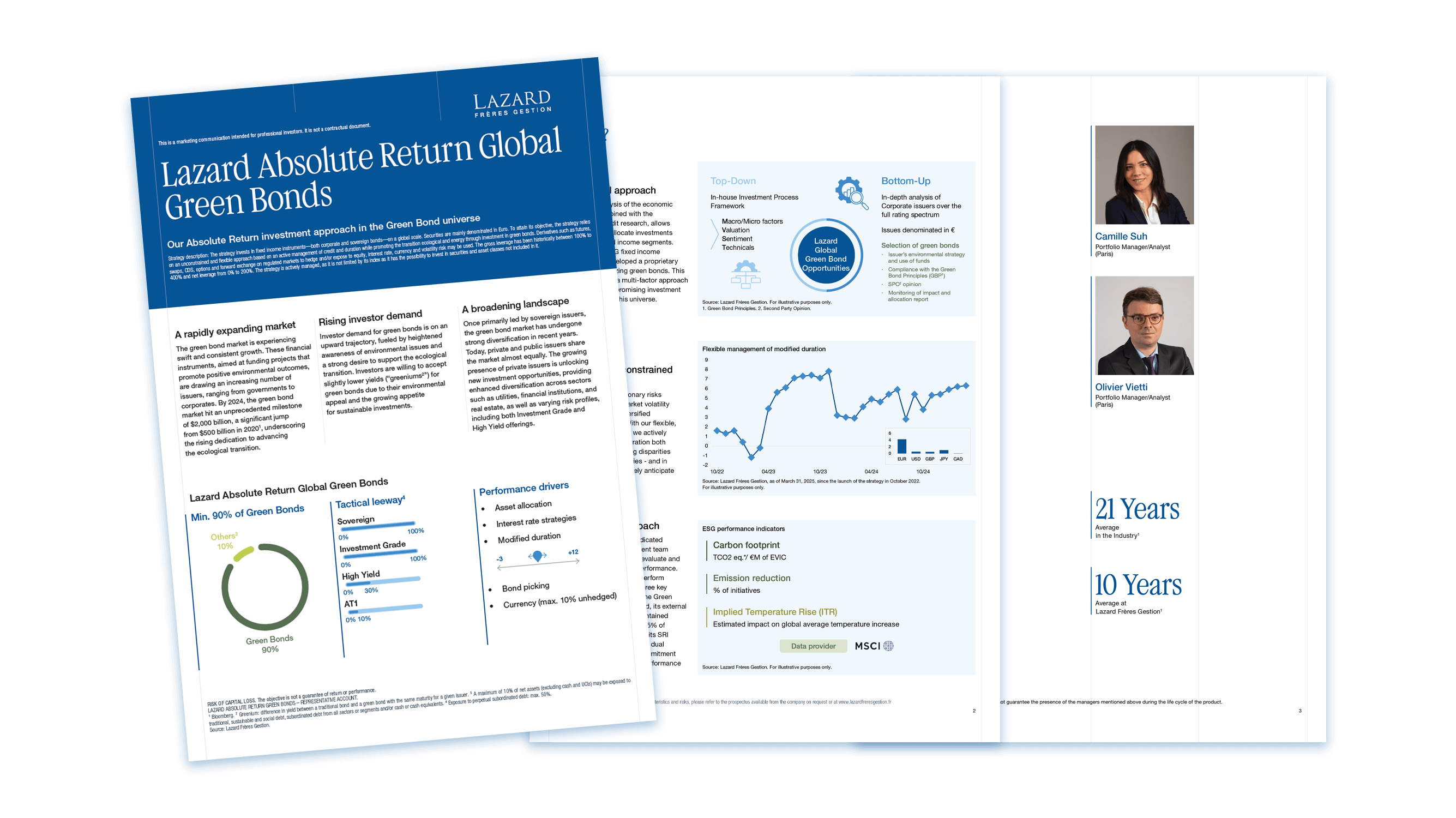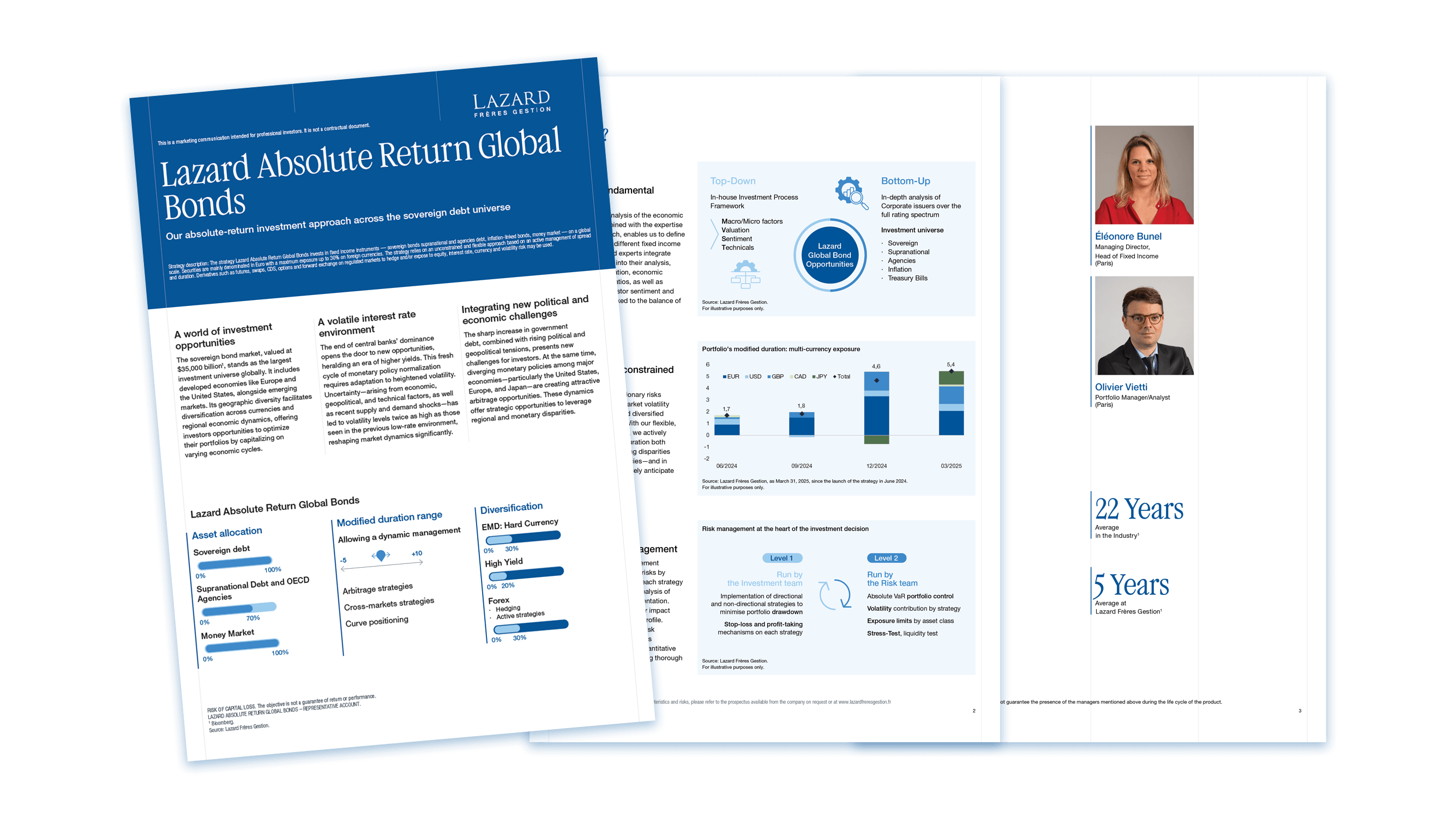This document is provided by Lazard Asset Management LLC, Lazard Frères Gestion or its affiliates ("Lazard") for informational purposes only. Nothing herein constitutes investment advice or a recommendation relating to any security, commodity, derivative, investment management service or investment product. Investments in securities, derivatives and commodities involve risk, will fluctuate in price, and may result in losses. Certain assets held in Lazard’s investment portfolios, in particular alternative investment portfolios, can involve high degrees of risk and volatility when compared to other assets. Similarly, certain assets held in Lazard’s investment portfolios may trade in less liquid or efficient markets, which can affect investment performance. Past performance does not guarantee future results.
Any yield quoted is gross and is not guaranteed. It is subject to fees, taxation (particularly where presented gross of fees and taxes, which is specifically relevant for retail clients with Belgian residence) and charges within the portfolio and the investor will receive less than the gross yield. There can be no assurance that the portfolio's objectives or performance target will be achieved. Any views expressed herein are subject to change.
For more information on our ESG investment policy, please refer to this link: https://www.lazardfreresgestion.fr/EN/ESG-ISR/Notre-approche_147.html#section05.
The tax treatment of each client will vary, and you should seek professional tax advice.
For any complaints, please contact the representative of the LAM, or LFG office for your country. You will find the contact details below.
The contents of this document are confidential and should not be disclosed other than to the person or persons for whom it is intended.
This document is intended only for persons residing in jurisdictions where its distribution or availability is in compliance with local laws and Lazard's applicable regulatory approvals. Selling and taking possession of investments involves increased risk, and there is a possibility that the portfolio may not be able to recover the sums invested. The Lazard entities that have issued this document are listed below, along with important limitations on their authorized activities.
Australia: Issued by Lazard Asset Management Pacific Co., ABN 13 064 523 619, AFS License 238432, Level 12 Gateway, 1 Macquarie Place, Sydney NSW 2000, which is licensed by the Australian Securities and Investments Commission to carry on a financial services business. This document is intended for wholesale investors only.
Canada: Issued by Lazard Asset Management (Canada) Inc., 30 Rockefeller Plaza, New York, NY 10112 and 130 King Street West, Suite 1800, Toronto, Ontario M5X 1E3, a registered portfolio manager providing services to non-individual permitted clients.
Dubai: Issued and approved by Lazard Gulf Limited, Index Tower, Floor 10 Office 1008 DIFC, PO Box 506644, Dubai, United Arab Emirates. Registered in Dubai International Financial Centre 0467. Authorised and regulated by the Dubai Financial Services Authority to deal with Professional Clients only.
EU Member States: Issued by Lazard Asset Management (Deutschland) GmbH, Neue Mainzer Strasse 75, D-60311 Frankfurt am Main.
France: Issued by Lazard Frères Gestion, 25, rue de Courcelles, F-75008 Paris.
This document is intended only for persons residing in jurisdictions where its distribution or availability is in compliance with local laws and Lazard's applicable regulatory approvals. Selling and taking possession of investments involves increased risk, and there is a possibility that the portfolio may not be able to recover the sums invested.
Hong Kong: Issued by Lazard Asset Management (Hong Kong) Limited (AQZ743), Suite 1101, Level 11, Chater House, 8 Connaught Road Central, Central, Hong Kong. Lazard Asset Management (Hong Kong) Limited is a corporation licensed by the Hong Kong Securities and Futures Commission to conduct Type 1 (dealing in securities) and Type 4 (advising on securities) regulated activities only on behalf of “professional investors” as defined under the Hong Kong Securities and Futures Ordinance (Cap. 571 of the Laws of Hong Kong) and its subsidiary legislation.
Korea: Issued by Lazard Korea Investment Management Co., Ltd., 21F Seoul Finance Center, 136 Sejong-daero, Jung-gu, Seoul, 04520.
People’s Republic of China: Issued by Lazard Asset Management. Lazard Asset Management does not carry out business in the P.R.C and is not a licensed investment adviser with the China Securities Regulatory Commission or the China Banking Regulatory Commission. This document is for reference only and for intended recipients only. The information in this document does not constitute any specific investment advice on China capital markets or an offer of securities or investment, tax, legal or other advice or recommendation or, an offer to sell or an invitation to apply for any product or service of Lazard Asset Management.
Saudi Arabia: Issued and approved by Lazard Saudi Arabia, 15th Floor, Nakheel Tower, King Fahad Road, Nakheel District, Riyadh 12381, Saudi Arabia. Commercial Registration No: 1010297437 with a unified number: 7001642417, License of the Ministry of Investment No: 102031098747. Regulated and authorised by the Capital Market Authority (CMA).
Singapore: Issued by Lazard Asset Management (Singapore) Pte. Ltd., Unit 15-03 Republic Plaza, 9 Raffles Place, Singapore 048619. Company Registration Number 201135005W, which provides services only to “institutional investors” or “accredited investors” as defined under the Securities and Futures Act, Chapter 289 of Singapore.
Switzerland: Issued by Lazard Asset Management Schweiz AG, Uraniastrasse 12, CH-8001 Zurich.
United Kingdom: Issued or approved by Lazard Asset Management Limited, 20 Manchester Square, London, W1U 3PZ. Registered in England Number 525667. Authorised and regulated by the Financial Conduct Authority (FCA), providing services only to persons classified as eligible counterparties or professional clients under the rules of the FCA.
United States: Issued by Lazard Asset Management LLC, 30 Rockefeller Plaza, New York, NY 10112.





